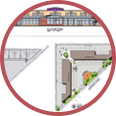Our Clients Have Prevailed in Over 95 Percent of the Cases We’ve Worked On in the Past 10 Years
Forensic Architecture | Planning and Urban Design for Real Estate
We Diagnose Causes and Solve Problems
Space Analytics addresses the designs and configurations of built environments. From the small scale of a sidewalk curb to commercial buildings and the large scale of street systems, we understand how they impact human use. We focus on design satisfaction, public space, architectural copyright, and premises liability. We have worked with investors, developers, non-profits, and plaintiff and defense attorneys to diagnose causes and solve problems.
Our Capabilities

Design Satisfaction / Problem Property
Factors in architecture, planning, site, and urban design that inhibit functional and economic performance.

Public Space
Disputes about peddling and vending, First Amendment public forums, anti-social behavior, and Fifth Amendment eminent domain access takings.

Premises Liability
Cases about serious pedestrian injuries, wrongful deaths, and pedestrian-driver-vehicle incidents.

Architectural Copyright
Trade dress infringements—tall buildings, luxury houses, custom houses, malls, and large multi-family dwellings.
Our Superior Approach
Several characteristics differentiate Space Analytics from other built environment professionals like architects, urban designers, appraisers, engineers, and planners in failure analysis and accident reconstruction.
- An innovative, reliable, and award-winning spatial modeling methodology
- High-level research and publication
- Multi-disciplinary knowledge
- Root cause analysis
These characteristics offer wide perspectives on problems and avoid surprises.
How the brain responds to spatial patterns depends on their legibility and complexity. Sometimes complexity is interesting. More complexity might be worth exploring. But a lot of complexity can be frustrating. Any complexity related to fire exits is dangerous. Different kinds of buildings and places require different levels of complexity.
Our methodology combines elements of neuroscience with geometry. Using spatial intervals based on neuron firings when we walk, it measures complexity by decomposing the spatial configuration of movement surfaces into convex and linear shape intervals.
Redefining Spaces Since 1989
I started Space Analytics in 1989 to solve the functional and economic problems of built environments from the perspective of owners and users. Our early projects focused on shopping centers with vacancy problems and HR problems in hi-tech offices. We analyzed the hospital design and the patient floors of two major tertiary-care hospitals in Manhattan. New projects involved hydroprocessing plant control rooms, architectural design competitions, hospitality, design in valuation contexts, shopping streets, very large luxury houses, and public space.
We focus strictly on places used by pedestrians, including how vehicle movement might affect pedestrians. We do not work on vehicle-to-vehicle accidents. Our research on architectural design signatures led to architectural copyright disputes, and our recognized knowledge of the functioning of built environments led to premises liability and public space disputes.
Project clients include high-tech firms, real estate consultants, architects, appraisers, investors, non-profits, manufacturers, health care providers, community organizations, business improvement districts, and local governments.
We've Worked on Many Cases for Small and Large Firms
Locations:
- Arizona
- California
- Colorado
- Florida
- Illinois
- Indiana
- Kentucky
- Nebraska
- Nevada
- Oklahoma
- Oregon
- Pennsylvania
- Texas
- Virginia
- Wyoming
Firms:
- Ball Janik
- Fairfield & Woods
- Foley Bezek Behle & Curtis
- Hilliard Munoz Gonzales
- Pisanelli Bice
- Kirkland & Ellis
- Lewis, Bribois, Bisgaard & Smith
- Morris Politch & Purdy
- O’Hagan Meyer
- Pretzel & Stouffer
- Thompson Coburn
- Wyatt, Tarrant & Combs
M. Gordon Brown, DTech, FRICS
Principal at Space Analytics, LLC
My career started in city planning, and that led to management consulting in Philadelphia and New York, focusing on communication issues. During that time, I began developing a methodology based on communication network analysis and cognitive mapping that would transform everyday spatial patterns of networks. I received manuscript awards from the American Real Estate Society for papers showing applications of the methodology. This methodology defines our distinctive competence.
My analyses have resulted in some of the highest damages awards in architectural copyright, in eight-digit premises liability awards, in recognizing substantial impairment of access, in the redesign of buildings and places, and in main street redevelopment plans leading to large property value increases.


